Abstract
We report column material for a 68Ge/68Ga generator with acid resistance and excellent adsorption and desorption capacity of 68Ge and 68Ga, respectively. Despite being a core element of the 68Ge/68Ga generator system, research on this has been insufficient. Therefore, we synthesized a low molecular chitosan-based TiO2 (LC-TiO2) adsorbent via a physical trapping method as a durable 68Ge/68Ga generator column material. The adsorption/desorption studies exhibited a higher separation factor of 68Ge/68Ga in the concentration range of HCl examined (0.01 M to 1.0 M). The prepared LC-TiO2 adsorbent showed acid resistance capabilities with >93% of 68Ga elution yield and 1.6 × 10−4% of 68Ge breakthrough. In particular, the labeling efficiency of DOTA and NOTA, by using the generator eluted 68Ga, was quite encouraging and confirmed to be 99.65 and 99.69%, respectively. Accordingly, the resulting behavior of LC-TiO2 towards 68Ge/68Ga adsorption/desorption capacity and stability with aqueous HCl exhibited a high potential for ion-exchange solid-phase extraction for the 68Ge/68Ga generator column material.
1. Introduction
Gallium-68 (68Ga) is a positron-emitting radionuclide obtained on-site using a 68Ge/68Ga generator without the need for an accelerator. 68Ga has a short half-life (t1/2; 67.71 min), decaying 89% through positron emission with a maximum energy of 1899.1 keV and a mean of 836.0 keV [1]. In human positron emission tomography/computed tomography (PET/CT), images reconstructed with PET spatial resolution phantom (68Ga) have shown a resolution of 7.0 mm full width at half maximum (FWHM) [2], which is suitable for clinical-based scanning. Therefore, 68Ga is a positron-emitting radionuclide that can be used equally with halogen radioisotopes (RIs) such as fluorine-18 and iodine-124. 68Ga-based radiopharmaceuticals are increasingly being used in nuclear medicine worldwide for PET/CT tests [3,4]. Over the past few decades, clinical PET imaging research using 68Ga has increased tremendously [5]. 68Ga-radiopharmaceuticals have been recognized for the diagnosis of bone infection and tumors. For example, 68Ga-labeled somatostatin receptor-specific peptides (SSTRs) [6], 1,4,7,10-tetra-azacyclododecane-1,4,7,10-tetraaceticacid-D-Phe1-Tyr3-octreotide (DOTATOC) in the European Union and DOTA-Tyr3-octreotate (DOTATATE) in the United States, are being used successfully for PET imaging [7,8].
68Ge/68Ga generators are commercially available worldwide, and their use in the medical field is increasing rapidly [9]. Therefore, researching 68Ge/68Ga generator column materials and studying the capability of adsorption and desorption of 68Ge and 68Ga radionuclides represent an urgent scientific need of the involved community. Most column adsorbents acting as the core elements of the 68Ge/68Ga generator use metal oxides [10]. In general, metal oxides have good adsorption capacities for metal ions and provide high surface area with varying surface functional groups that can interact with heavy metal ions [11,12]. As a result, they show remarkable potential for the removal of heavy metal ions. However, the metal oxide adsorbents are poor in acid-resistance [13]. A prefiltration process of eluted Ga-68 is performed to overcome this limitation. Different types of metal oxides have been intensively investigated for 68Ge/68Ga generator systems, such as SnO2, SiO2, TiO2, ZnO2 and Al2O3 [14,15,16]. However, such adsorbents have low acidic stability and high 68Ge breakthrough, which deteriorates over time.
Chitosan is a natural biopolymer obtained by the deacetylation of chitin. It is the main structural component of crustacean exoskeletons [17,18,19]. It is a biocompatible material and is harmless to the human body even when used as an inert support for adsorbents [20]. In particular, chitosan in the presence of amino and hydroxyl functional groups can react with metal ions by electrostatic forces and hydrogen bonds [20,21]. Furthermore, it is possible to increase the capacity of capturing metal ions by exerting a synergistic effect by titanium trapped on the chitosan polymeric matrix [17]. For the removal of heavy metal ions from wastewater, studies have been conducted based on chitosan-adsorbents. Still, as a material for adsorption/separation of RI generators, studies considering elution pressure, acid resistance, radiation resistance, and adsorption and desorption efficiency of RIs represent a new approach [22,23].
In a previous paper [24], we described the adsorption and desorption capacity of 68Ge/68Ga by synthesizing spherical chitosan-TiO2 of 700 μm. Compared to these results, we expect to improve the adsorption and desorption capacity of 68Ge/68Ga and acid-resistance by adjusting the size of the chitosan-TiO2 adsorbent using low molecular chitosan.
In this study, low molecular chitosan and titanium dioxide (P25) were used to develop 68Ge/68Ga generator column material to ensure the high adsorption/desorption capacity of 68Ge (parent nuclide)/68Ga (daughter nuclide), respectively, while maintaining its stability in hydrochloric acid, which is generally used as a 68Ga eluent (Scheme 1).
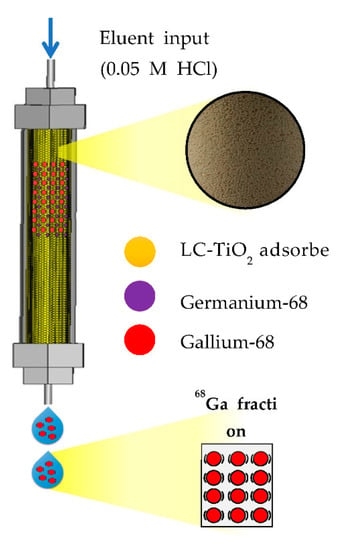
Scheme 1.
Scheme of a 68Ge/68Ga generator column system based on the chitosan-TiO2 absorbent.
2. Results
2.1. Preparation and Characterization of LC-TiO2
Low molecular chitosan and titanium dioxide were used as an inert support and stationary phase to synthesize a microsized LC-TiO2 adsorbent with excellent adsorption/desorption capability for 68Ge/68Ga, while securing stability towards corrosive HCl. The reaction of viscous acetic acid-based low molecular chitosan with titanium dioxide (P25) precursor formed a chitosan-titanium composite-based polymeric matrix. (Figure 1).
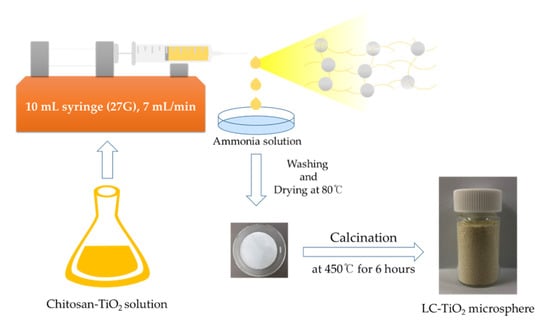
Figure 1.
Synthesis procedure for low molecular chitosan-TiO2 adsorbent via physical deposition method.
The synthesized LC-TiO2 adsorbent was characterized for particle size, surface morphology and elementary composition with a scanning electron microscope-energy dispersive X-ray spectrometer (SEM-EDX) and elemental mapping system. SEM images of LC-TiO2 adsorbent are shown in Figure 2. In Figure 2a, the average particle size of the synthesized LC-TiO2 is around 250 ± 30 μm. At higher magnification (Figure 2b,c), the TiO2 trapped chitosan polymer was confirmed, which was physically bonded in a polymeric structure. Besides, elemental mapping showed that titanium nanoparticles were evenly distributed in the LC-TiO2.
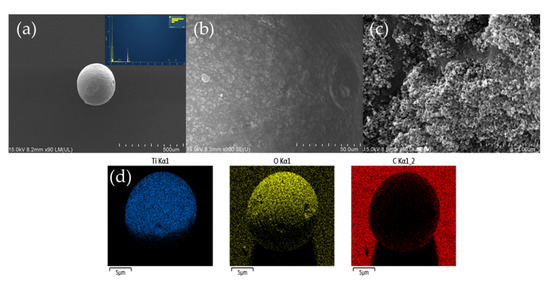
Figure 2.
SEM images of LC-TiO2 adsorbent (a) magnification 80× (b) magnification 1100× (c) magnification 50,000× and elements maps (d) magnification 70× (scale = 5 μm) from SEM-EDX.
Figure 3a shows the X-ray diffraction (XRD) pattern of LC-TiO2 adsorbent prepared by a mechanical stirring method. The XRD peaks can be perfectly indexed to the anatase and rutile structures of TiO2 (COD No. 9015929 and ICDD No. 01-088-1172, respectively). The average crystallite size (Å) of LC-TiO2 adsorbent can be estimated according to the diffraction and reflection using the Williamson-Hall method. The crystallinity of anatase and rutile phases was confirmed, which has an individual crystal size of 167 and 653 Å. The crystal phase and size were similar to P25, reflecting the physical sorption to the chitosan polymeric template without modification of P25 during synthesis.
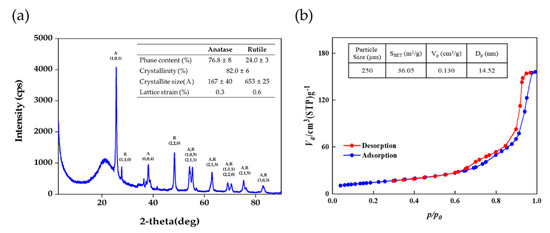
Figure 3.
Characterization of LC-TiO2 adsorbent with (a) X-ray diffraction pattern and (b) N2 adsorption/desorption capacity.
The nitrogen adsorption-desorption (BET) isotherm (Figure 3b) of LC-TiO2 adsorbent was measured. The pore size distribution plot was measured using the Barrett–Joyner–Halenda (BJH) method from the desorption branch of the isotherm. The physical properties were measured with a high surface area of 36.05 m2·g−1, pore-volume and pore size of 0.13 cm3·g−1 and 14.52 nm, respectively.
2.2. Acid Resistance
Metallic impurities (Table 1) were measured after immersing LC-TiO2 in 0.05 M HCl eluent. The concentration of titanium ion was confirmed to be 4 ppb. The level of titanium was too low, proving the mechanical stability of the synthesized composite. Considering the material stability and the half-life of 68Ge (parent radionuclide) of ~271 days, the column material can be used as a 68Ge/68Ga generator for >1 year. Besides, the concentration of other metallic impurities such as Sc, V, Cr, Mn, Zn, Ru, Rh, Pd, Ag, and Cd were determined in immersed LC-TiO2 with 0.05 M HCl and found to be at extremely low levels and always under 15 ng·mL−1 (ppb) as shown in Table 1.

Table 1.
Measured metallic impurities in unit of ppb (ng·mL−1), in 0.05 M hydrochloric acid and blank, after incubation of the LC-TiO2 adsorbent.
2.3. Distribution Coefficient
The distribution coefficient of 68Ge(IV)/68Ga(III) ions on the LC-TiO2 adsorbent at different molarity of HCl are displayed in Figure 4. The Kd value of parent radionuclide 68Ge(IV) was maximum at pH 2 while the 68Ga(III) was less than 1 mL·g−1 at 0.05 M HCl. In theory, at concentrations lower than 0.01 M HCl, the Kd value should increase by hydrolysis of the Ga ion [25]. The Ga(III) ion changes from Ga3+→Ga(OH)2+→Ga(OH)2+→Ga(OH)3 to Ga(OH)4−, which is expected for the reduced desorption capacity of the Ga (III) ion. In addition, 68Ge(IV) was evaluated for having high adsorption capacity (Kd; 3512 ± 0.630 mL·g−1). The 68Ge/68Ga separation factor (SF) using metal oxide is about ~102. In particular, the SF for titanium dioxide is ~230. In contrast, the adsorbent developed in this study showed that was more than 1000 time higher.
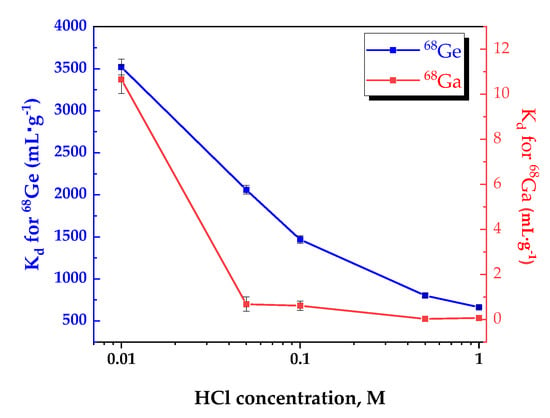
Figure 4.
The distribution coefficient of 68Ge and 68Ga in various conc. HCl with LC-TiO2.
2.4. Column Study
Evaluation of the adsorption capacity of 68Ge depending on time is required for preparing the 68Ge/68Ga generator column material. The adsorption yield of 68Ge reached the maximum capability within 3 h (Figure 5). The elution profile (Figure 6) of 68Ga depended on the HCl concentration. >93% of the 68Ga radioactivity was eluted with 0.05M HCl in the 1 mL volume due to the high separation factor of 68Ge/68Ga. The breakthrough of 68Ge was confirmed to be 1.6 × 10−4%. This result guarantees the quality of 68Ga-radiopharmaceuticals.
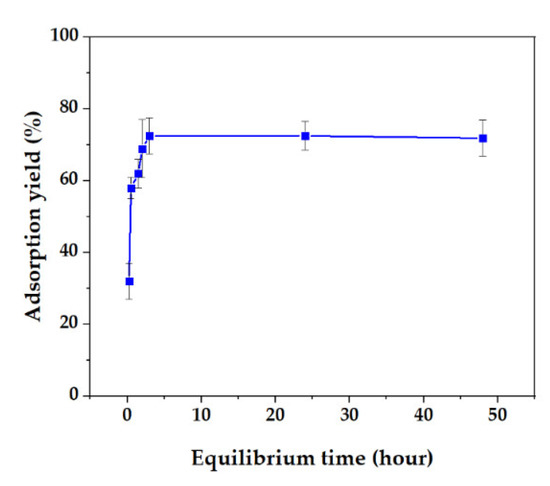
Figure 5.
The adsorption capacity of 68Ge depending on incubation time.

Figure 6.
Elution profile of 68Ga from LC-TiO2 column.
2.5. Radiolabeling and In Vivo Evaluation
After the reaction, radiochemical yields% (RCY%) of 68Ga-DOTA and 68Ga-NOTA were 99.65% and 99.69%, respectively. Experimental data are supplied for each chelator in Figure 7a–c.
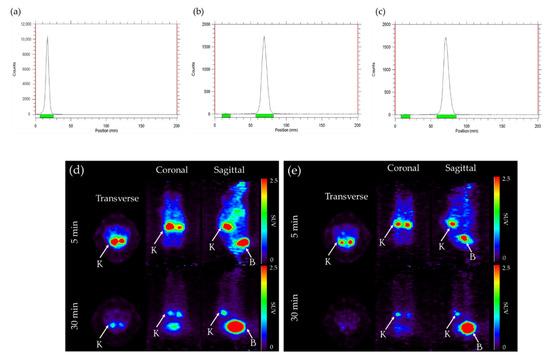
Figure 7.
68Ga labeling study. Radio instant thin layer chromatography of (a) 68Ga-chloride, (b) 68Ga-DOTA, and (c) 68Ga-NOTA on silica-gel papers developed in MeOH/10%NH4OAc as a mobile phase under optimized conditions. Whole-body PET images of balb/c mice at 5 min and 30 min post injection of 1.1 MBq of (d) 68Ga-DOTA and (e) 68Ga-NOTA.
In vivo small-animal PET studies using 68Ga-DOTA and 68Ga-NOTA (Figure 7b) show the possibility of introducing 68Ga eluted from the column into radiopharmaceuticals. Radiolabeled DOTA and NOTA chelators are potential candidates for the diagnosis of various diseases and cancer. Radiolabelled 68Ga exhibited high accumulation in kidney and low uptake in normal tissues in a mouse model, as shown in Figure 7.
3. Discussion
The LC-TiO2 adsorbent was synthesized by a physical deposition method. This method is effective in enhancing the trapping of titanium dioxide nanoparticles in the polymeric chitosan. The synthesized LC-TiO2 was characterized by SEM, EDX, XRD and BET equipment.
The size and morphology of the adsorbent were confirmed through SEM analysis. LC-TiO2 was synthesized to enhance the conditions (elution pressure, stability, adsorption/desorption capacity) necessary for its use as a column material for a 68Ge/68Ga generator system. Compared to the 700 µm sized chitosan-TiO2 adsorbent in our previous study [24], spherical LC-TiO2 of 250 µm was synthesized, which has low elution pressure and high reactivity between the eluent and the adsorbent. In the EDX and mapping element analysis results, it was speculated that TiO2 could effectively react with 68Ge and 68Ga metal ions and confirming that Ti is evenly distributed in the chitosan template.
The TiO2 used in this study was Degussa P25 of about 21 nm commercial size, with a mixture of about 80% anatase and 20% rutile in XRD measurements. After a physical trap reaction of low molecular chitosan and TiO2, it was confirmed that the homozygous polymorphic form of anatase and rutile was maintained. Titanium tetraisopropoxide (TTIP) used as a Ti source other than P25 can be hydrolyzed and undergo a phase transition from an anatase phase to a rutile structure even at low temperatures by H+ generated as a by-product. It is known that the ratio of the rutile phase increases [26].
Figure 3b shows the N2-sorption graph and pore distribution obtained through BET measurement of LC-TiO2. The BET-specific surface area of the LC-TiO2 adsorbent prepared by the physical trap method was measured to be 36.05 m2·g−1. From the N2-sorption graph in 3(b), it can be seen that pores of 14.52 nm exist due to the difference in the adsorption and desorption curves occurring at the point where the relative pressure is about 0.6.
In the acid resistance results, the content of metal impurities was measured using ICP-MS (inductively coupled plasma-mass spectrometer) equipment. Stability evaluation of the elution pressure of 68Ga and hydrochloric acid as eluent was performed to determine whether it could be introduced as a column material for a 68Ge/68Ga generator. Since a low-molecular chitosan-Ti based adsorbent is used, stability in an acid solution against Ti metal ions must be secured. In general, Ti4+ ion can be derived from Ti metal using acid, during which there is a migration of H+ ions from the acid to the metal surface, forming H+ and H2 [13]. The analysis of metal element content confirmed that background-level elements were included, and further studies are being conducted to secure long-term stability.
The distribution coefficient of 68Ge and 68Ga on LC-TiO2 at different molarities of HCl is displayed in Figure 4. The adsorption capacity of 68Ge was maximum at 0.01 M HCl, and the trend continued to decrease. The Kd value of 68Ga is shown, which had a slight difference, and a similar level of high desorption ability above a concentration of 0.05 M HCl.
Considering the distribution coefficient results of 68Ge and 68Ga, a column study was performed using 0.05 M hydrochloric acid with a high SF value (SF68Ge/68Ga = 2984 ± 9.542).
The 68Ge source was dispersed in 0.01 M HCl, and then adsorbed onto LC-TiO2 adsorbent for 3 h in consideration of the previously evaluated adsorption/desorption capacity of 68Ge/68Ga. The unbounded 68Ge was removed from the column with 20 mL of 0.05 M HCl. After 24 h, 68Ga was eluted using 0.05 M HCl at a flow rate of 0.5 mL·min−1. The final eluted 68Ga-chloride was evaluated for metallic impurities, elution yield, breakthrough and fraction volume (Table 2). Based on encouraging results from the tests, we provided suggestions for future studies and the use of LC-TiO2 as a 68Ge/68Ga generator column material.

Table 2.
Performance of LC-TiO2 adsorbent column.
4. Materials and Methods
4.1. General
Low-molecular weight chitosan (MW 50,000–190,000 Da, cP 20–300) and P25 (titanium(IV) oxide, 21 nm) were obtained (Sigma-Aldrich, Saint Lousis, MO, USA). For the labeling study, DOTA and NOTA chelator were obtained from MacrocyclicTM. All optima grade acid solutions were purchased from Fisher Scientific (Waltham, MA, USA) and used without further purification. The 68Ge-chloride source was obtained from Eckert & Ziegler (Berlin, Germany). 68Ge/68Ga generator (Eckert & Ziegler, Berlin, Germany) was used for a distribution coefficient of 68Ga with 0.1 M HCl of an eluent. The activities of 68Ge and 68Ga were measured by a dose calibrator (AtomlabTM, Biodex, New York, NY, USA). For measurement of 68Ge breakthrough, a gamma counter (1480 WIZARD-3, Perkin Elmer, Trenton, NJ, USA) was used, and an in vivo study was conducted using a bench-top PET/X-ray system (Genesis 4, Perkin Elmer, Trenton, NJ, USA).
4.2. Preparation and Characterization of Chitosan-TiO2 Adsorbent
The most common method for synthesizing chitosan-TiO2 is mechanical stirring, followed by titanium metal trapped on the chitosan polymeric matrix (Figure 1). Solution I: 1.5 g of low molecule chitosan was dissolved in 5% acetic acid for 24 h. Solution II: 38.4 mL of absolute ethanol (99%) was mixed with 45 mL of TTIP dispersed in 6 mL of conc. HCl. TiO2 metal powder (P25) (10 g) was added to the above mixture (solution II) and allowed to homogenize using an overhead stirrer for 16 h. The premixed solution was reacted with constant stirring for 2 h. After thorough homogenization of low molecular chitosan-TiO2 (LC-TiO2), the mixture was dropped into a 28% ammonia solution using a syringe pump (needle: 27G, flow rate: 7 mL·min−1). The squashy LC-TiO2 particles were washed and filtered by gravity with distilled water and dried for 12 h at 80 °C. Finally, prebuilt LC-TiO2 was calcinated for 6 h at 450 °C using a muffle furnace (10 °C·min−1).
4.3. Acid Resistance Study
The acid resistance of low-molecular weight chitosan-TiO2 (LC-TiO2) was estimated by focusing on the 68Ga elution of extractants. The LC-TiO2 adsorbent was placed in a 15 mL conical tube, followed by 5 mL of hydrochloric acid at various concentrations (0.01 M to 1.0 M). Then, physical stress was applied at 200 rpm for 1 to 48 h. After batch immersing experiments, the supernatant was collected and measured for metallic impurities by ICP-MS (7500 series, Agilent Technology, Inc., Santa Clara, CA, USA).
4.4. Distribution Coefficients (Kd)
The distribution coefficients of 68Ge and 68Ga with the LC-TiO2 were carried out with various HCl concentrations (0.01 M to 1.0 M) at 37 °C for 3 h to determine their adsorption capacity. In brief, the 68Ge/68Ga equilibrated source (Eckert & Ziegler) was used for the Kd experiment.
The 68Ge/68Ga solutions (~37 kBq) were added to the LC-TiO2 and shook constantly. After reaching the adsorption equilibrium, adsorbents were filtered out from equilibrium solutions. The filtered solutions were determined instantly and after 24 h using a gamma counter. The calculation of the Kd was carried out as
where Kd is the distribution coefficient (mL·g−1), Ai is initial aqueous phase activity of 68Ge/68Ga before equilibration, Aeq is final aqueous phase activity of 68Ge/68Ga after equilibration V is the volume (unit: mL) and m is the mass of adsorbent (grams).
4.5. Column Study
5 g of LC-TiO2 was wet-packed into a 5 mL empty column (Eichrom) with 0.05 M HCl containing 74 MBq of 68Ge/68Ga solution. 68Ga elution ability was tested under conditions of a flow rate of 5 mL·min−1 and gravity. The column was connected with a syringe pump using fluoropolymer resin tubing. After 68Ge/68Ga equilibrium, the column was rinsed with 20 mL of 0.01 M HCl to remove the unbound 68Ge and then was left to stand for 24 h to demonstrate its performance. The column studies were repeated to confirm reproducibility.
4.6. 68Ga Elution Profile and 68Ge Breakthrough
Ten fractions of 1 mL volume were eluted at 0.5 mL·min−1 flow rate with a syringe pump for evaluating the elution yield of Ga. After 24 h, the remaining radioactivity was measured with a gamma counter to determine the breakthrough of 68Ge.
4.7. Equilibrium Time of 68Ge/68Ga
The synthesized LC-TiO2 was completely soaked in 0.01 M HCl and then the supernatant was removed. 68Ge stock solution (in 0.01 M HCl) (3.7 MBq) was added to the activated LC-TiO2 adsorbent. The time to reach the 68Ge/68Ga equilibrium was evaluated by measuring the radioactivity over time for 50 h with a dose calibrator.
4.8. Radiolabeling and In Vivo Evaluation
Chelators (10 μM of DOTA and NOTA, respectively) were dissolved in sodium acetate (0.25 M, pH 4.5) solution. Chelator solutions were freshly prepared from stock solutions for each experiment. The 68Ga-chloride solution (~59 MBq·mL−1) was purged with inert N2 gas at 90 °C for 20 min (volume; <50 µL). 68Ga activity was added to the chelator solution (150 µL), and the reaction solutions were incubated at 100 °C and 25 °C, respectively. Samples of 68Ga-DOTA and NOTA measured 12 min after labeling (Stationary phase: iTLC-SG, Mobile phase: 1:1/MeOH:10% NH4OAc) are shown in Figure 7b,c.
For PET image scanning, balb/c mice were anesthetized with 2% isoflurane, and 68Ga labeled compounds were injected by intravenous tail injection. PET images were acquired 5 and 30 min after injection.
5. Conclusions
In summary, we demonstrated that synthesized low molecular weight chitosan-TiO2 can function as a column adsorbent for a 68Ge/68Ga generator. The fractions of the radionuclide generator need to be eluted and used immediately in the medical field, should not contain metallic impurities and must be used with high specific activity. Commercially available 68Ge/68Ga generators have a low labeling efficiency of 68Ga with chelator agents due to metallic impurities in the final 68Ga elution. The filter process of 68Ga elution is generally conducted before the manufacture of 68Ga-radiopharmaceuticals to avoid the effect of labeling yield by containing impure metals. We have developed a column adsorbent, which can overcome these limitations. The metallic impurities of the 68Ga eluate were very low and had excellent 68Ge/68Ga adsorption and desorption capacities. Based on these results, we propose the use of LC-TiO2 adsorbent for a 68Ge/68Ga generator system with promising elution efficiency and stability and having the capability to provide a high purity of 68Ga elution (>99.9%) with 10−4% of 68Ge breakthrough.
Author Contributions
Conceptualization, J.-Y.L.; data curation, J.-Y.L.; formal analysis, J.-Y.L.; funding acquisition, J.-H.P.; investigation, J.-Y.L. and P.-S.C.; methodology, J.-Y.L.; project administration, J.-H.P.; validation, J.-H.P. and S.-D.Y.; visualization, J.-Y.L.; writing—original draft, J.-Y.L.; writing—review & editing, J.-H.P. and S.-D.Y. All authors have read and agreed to the published version of the manuscript.
Funding
This research was supported by the Nuclear R&D Program through the National Research Foundation of Korea, funded by the Ministry of Science, ICT, and Future Planning (2017M2A2A6A05016600 and 2021M2E7A1079112) and NTIS, Republic of Korea.
Institutional Review Board Statement
The study was conducted according to institutional animal care and use committee (IACUC) guidelines provided by Korea Atomic Energy Research Institute (IACUC number: KAERI 2021-010).
Informed Consent Statement
Not applicable.
Data Availability Statement
Not applicable.
Acknowledgments
This study was supported by a National Research Foundation Grant funded by the Korean Government (2017M2A2A6A05016600 and 2021M2E7A1079112) and NTIS, Republic of Korea.
Conflicts of Interest
The authors declare no conflict of interest. The funders had no role in the design of the study; in the collection, analyses, or interpretation of data; in the writing of the manuscript, or in the decision to publish the results.
Sample Availability
Samples of the compounds are not available from the authors.
References
- Bé, M.M.; Schönfeld, E. Table de Radionucléide. 2012. Available online: http://www.nucleide.org/DDEP_WG/DDEPdata.htm (accessed on 9 April 2021).
- Sanchez-Crespo, A. Comparison of Gallium-68 and Fluorine-18 imaging characteristics in positron emission tomography. Appl. Radiat. Isot. 2013, 76, 55–62. [Google Scholar] [CrossRef]
- Banerjee, S.R.; Pomper, M.G. Clinical applications of Gallium-68. Appl. Radiat. Isot. 2013, 76, 2–13. [Google Scholar] [CrossRef] [PubMed]
- Fani, M.; Andre, J.P.; Maecke, H.R. 68Ga-PET: A powerful generator-based alternative to cyclotron-based PET radiopharmaceuticals. Contrast Media Mol. Imaging 2008, 3, 53–63. [Google Scholar] [CrossRef] [PubMed]
- Velikyan, I. 68Ga-based radiopharmaceuticals: Production and application relationship. Molecules 2015, 20, 12913–12943. [Google Scholar] [CrossRef] [PubMed]
- Pauwels, E.; Cleeren, F.; Bormans, G.; Deroose, C.M. Somatostatin receptor PET ligands-the next generation for clinical practice. Am. J. Nucl. Med. Mol. Imaging 2018, 8, 311. [Google Scholar] [PubMed]
- Ray Banerjee, S.; Chen, Z.; Pullambhatla, M.; Lisok, A.; Chen, J.; Mease, R.C.; Pomper, M.G. Preclinical comparative study of 68Ga-labeled DOTA, NOTA, and HBED-CC chelated radiotracers for targeting PSMA. Bioconjug. Chem. 2016, 27, 1447–1455. [Google Scholar] [CrossRef]
- Tsionou, M.I.; Knapp, C.E.; Foley, C.A.; Munteanu, C.R.; Cakebread, A.; Imberti, C.; Eykyn, T.R.; Young, J.D.; Paterson, B.M.; Blower, P.J. Comparison of macrocyclic and acyclic chelators for gallium-68 radiolabelling. RSC Adv. 2017, 7, 49586–49599. [Google Scholar] [CrossRef]
- Rösch, F. Past, present and future of 68Ge/68Ga generators. Appl. Radiat. Isot. 2013, 76, 24–30. [Google Scholar] [CrossRef]
- Chakravarty, R.; Chakraborty, S.; Ram, R.; Vatsa, R.; Bhusari, P.; Shukla, J.; Mittal, B.; Dash, A. Detailed evaluation of different 68Ge/68Ga generators: An attempt toward achieving efficient 68Ga radiopharmacy. J. Label. Compd. Radiopharm. 2016, 59, 87–94. [Google Scholar] [CrossRef]
- Kumar, K.Y.; Muralidhara, H.; Nayaka, Y.A.; Balasubramanyam, J.; Hanumanthappa, H. Low-cost synthesis of metal oxide nanoparticles and their application in adsorption of commercial dye and heavy metal ion in aqueous solution. Powder Technol. 2013, 246, 125–136. [Google Scholar] [CrossRef]
- Mironyuk, I.; Tatarchuk, T.; Vasylyeva, H.; Naushad, M.; Mykytyn, I. Adsorption of Sr (II) cations onto phosphated mesoporous titanium dioxide: Mechanism, isotherm and kinetics studies. J. Environ. Chem. Eng. 2019, 7, 103430. [Google Scholar] [CrossRef]
- Mainier, F.B.; Monteiro, L.P.; Tavares, S.S.; Leta, F.R.; Pardal, J.M. Evaluation of titanium in hydrochloric acid solutions containing corrosion inhibitors. IOSR J. Mech. Civ. Eng. 2003, 10, 66–69. [Google Scholar] [CrossRef]
- de Blois, E.; Chan, H.S.; Naidoo, C.; Prince, D.; Krenning, E.P.; Breeman, W.A. Characteristics of SnO2-based 68Ge/68Ga generator and aspects of radiolabelling DOTA-peptides. Appl. Radiat. Isot. 2011, 69, 308–315. [Google Scholar] [CrossRef] [PubMed]
- Egamediev, S.; Khujaev, S.; Mamatkazina, A. Influence of preliminary treatment of aluminum oxide on the separation of 68Ge-68Ga radionuclide chain. J. Radioanal. Nucl. Chem. 2000, 246, 593–596. [Google Scholar] [CrossRef]
- Lin, M.; Ranganathan, D.; Mori, T.; Hagooly, A.; Rossin, R.; Welch, M.J.; Lapi, S.E. Long-term evaluation of TiO2-based 68Ge/68Ga generators and optimized automation of [68Ga] DOTATOC radiosynthesis. Appl. Radiat. Isot. 2012, 70, 2539–2544. [Google Scholar] [CrossRef] [PubMed]
- Anaya-Esparza, L.M.; Ruvalcaba-Gómez, J.M.; Maytorena-Verdugo, C.I.; González-Silva, N.; Romero-Toledo, R.; Aguilera-Aguirre, S.; Pérez-Larios, A. Chitosan-TiO2: A Versatile Hybrid Composite. Materials 2020, 13, 811. [Google Scholar] [CrossRef] [PubMed]
- Deveci, I.; Doğaç, Y.I.; Teke, M.; Mercimek, B. Synthesis and characterization of chitosan/TiO2 composite beads for improving stability of porcine pancreatic lipase. Appl. Biochem. Biotechnol. 2015, 175, 1052–1068. [Google Scholar] [CrossRef]
- Jiang, R.; Zhu, H.-Y.; Chen, H.-H.; Yao, J.; Fu, Y.-Q.; Zhang, Z.-Y.; Xu, Y.-M. Effect of calcination temperature on physical parameters and photocatalytic activity of mesoporous titania spheres using chitosan/poly (vinyl alcohol) hydrogel beads as a template. Appl. Surf. Sci. 2014, 319, 189–196. [Google Scholar] [CrossRef]
- Kravanja, G.; Primožič, M.; Knez, Ž.; Leitgeb, M. Chitosan-based (Nano) materials for novel biomedical applications. Molecules 2019, 24, 1960. [Google Scholar] [CrossRef]
- Franca, E.F.; Freitas, L.C.; Lins, R.D. Chitosan molecular structure as a function of N-acetylation. Biopolymers 2011, 95, 448–460. [Google Scholar] [CrossRef]
- Rashid, S.; Shen, C.; Yang, J.; Liu, J.; Li, J. Preparation and properties of chitosan–metal complex: Some factors influencing the adsorption capacity for dyes in aqueous solution. J. Environ. Sci. 2018, 66, 301–309. [Google Scholar] [CrossRef]
- Upadhyay, U.; Sreedhar, I.; Singh, S.A.; Patel, C.M.; Anitha, K. Recent advances in heavy metal removal by chitosan based adsorbents. Carbohydr. Polym. 2020, 251, 117000. [Google Scholar] [CrossRef] [PubMed]
- Vyas, C.K.; Lee, J.Y.; Hur, M.G.; Yang, S.D.; Kong, Y.B.; Lee, E.J.; Park, J.H. Chitosan-TiO2 composite: A potential 68Ge/68Ga generator column material. Appl. Radiat. Isot. 2019, 149, 206–213. [Google Scholar] [CrossRef]
- Luong, H.T.; Liu, J. Flotation separation of gallium from aqueous solution–effects of chemical speciation and solubility. Sep. Purif. Technol. 2014, 132, 115–119. [Google Scholar] [CrossRef]
- Bacsa, R.R.; Grätzel, M. Rutile formation in hydrothermally crystallized nanosized titania. J. Am. Ceram. Soc. 1996, 79, 2185–2188. [Google Scholar] [CrossRef]
Publisher’s Note: MDPI stays neutral with regard to jurisdictional claims in published maps and institutional affiliations. |
© 2021 by the authors. Licensee MDPI, Basel, Switzerland. This article is an open access article distributed under the terms and conditions of the Creative Commons Attribution (CC BY) license (https://creativecommons.org/licenses/by/4.0/).